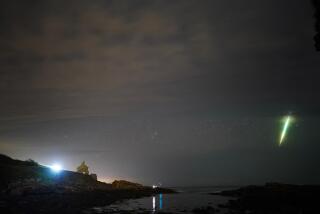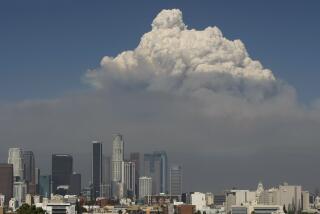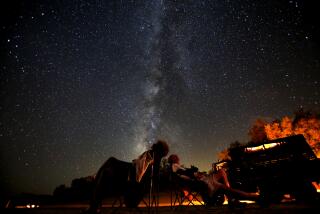Sky Keeps Raining Great Balls of Fire
DENVER — The phone lines to Denver’s Museum of Natural History have been buzzing since a fireball streaked across the Front Range sky in January.
That flash of light, caught on a homeowner’s security camera, was not an isolated incident; it was followed by at least four more fireball sightings, said Jack Murphy of the museum’s geology department, who hopes to find pieces of the celestial objects for the museum’s collection.
As new reports of sightings keep coming in, scientists are debating the meteorites’ origin and the meaning of the increased activity. There is more at stake, they say, than where a piece of rock fell to the ground.
“These little things are the little brothers and sisters of the bigger ones,” said Doug Revelle, a scientist at Los Alamos National Laboratory. “The reason for the interest is eventually a big one is going to hit, a real big one. And the question is: Can we protect ourselves?”
If a large meteor hit Earth, “life as we know it would be very different,” he said.
When a fireball fell into the Earth’s atmosphere on Jan. 11, a Front Range resident’s security camera documented the bright light along with the sonic boom caused by the apparent meteorite, Revelle said.
Scientists will use the time between the flash and boom--132 seconds--to help determine where the meteorite touched down, assuming it didn’t burn out before landing.
Then, about noon on Jan. 27, a commercial airline pilot flying over Wyoming spotted “a ball of flame trailing smoke.”
“He reported he did get some turbulence from the object,” Jim Patton, operations supervisor for the Federal Aviation Administration’s flight service center in Casper, told the Rawlins, Wyo., Daily Times. “He saw the debris and felt the shock wave from it.”
Breckenridge residents also reported seeing that daytime fireball. Murphy said they believe the space rock was heading south to north and landed just north of Hanna, Wyo.
Then that night another fireball broke into Earth’s atmosphere.
Scientists believe that meteorite came down in southern Colorado or northern New Mexico, Murphy said. People in Breckenridge spotted that fireball as well.
“That one was seen traveling east to west,” Murphy said. “It has been a long time since we’ve seen one moving like that.”
Another meteorite was seen and heard at sunrise in eastern Colorado on Jan. 30. And Murphy is investigating still another report that came in later.
So what’s happening?
“I don’t know,” Murphy said. “We can’t attribute it to anything. But it is unusual to have so much activity.”
University of Denver astronomer Robert Stencel suggested Earth may be getting hit with pieces of the Hale-Bopp comet. Early in January, Earth passed through the part of space the comet had traveled.
“Comets are like kids with muddy boots,” Stencel said. “They leave a trail of debris in their wakes.”
Meteorites from asteroids breaking out of the orbital belts between Mars and Jupiter are made up of metals, mostly iron. A meteorite from a comet would have a lighter element composition, Stencel said.
Such space debris is rare and would be of great scientific value, he said. Scientists will test the composition of the meteorites--if they can get their hands on them.
Revelle said he’s excited about the meteorite activity, but he can’t account for it.
The reports describe a smoke trail following the fireballs--or bolides, which are exploding meteors.
“The smoke trail is an indication that the object was quite big and strong,” Revelle said. “Over the globe we see objects that are about a meter across an average of only 12 times a year.”
Last Oct. 10, a meteorite crashed near West Texas and New Mexico; then, on Dec. 9, a large fireball crashed near Greenland; and on Dec. 13, a meteorite was seen across hundreds of miles, from Minnesota and Wisconsin south into Iowa and northern Missouri.
“In order to defend the Earth from a large meteor, we would need to know about it while it was months away to deflect it,” Revelle said. “If we knew about it when it was weeks away, it would be too late.”






